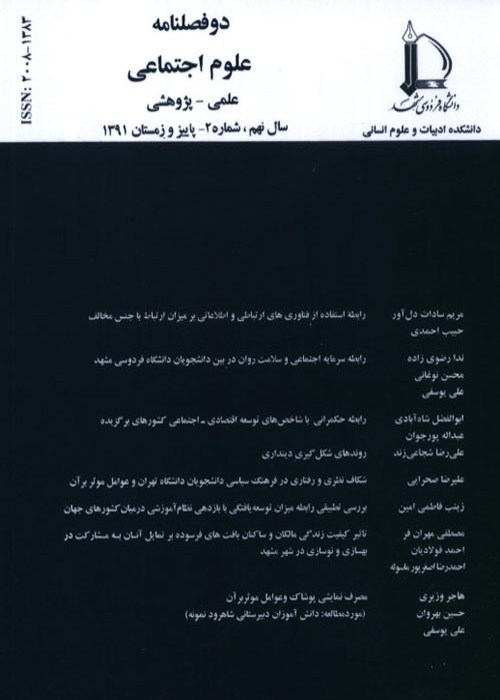Social Capital and Social Coexistence (The Case of Pre-university School Girls in Tabriz City, 2012)
Author(s):
Abstract:
Introduction
Co-existence is a mental-behavioral state held in common with members of a society, within which others are accepted as legitimate and equal-right partners. Becoming a common practice, co-existence can increase the level of corporation and social participation and reconcile the senses of value conflicts in the society. Because of inter and intra-societal diversities and complexities of social relations, social co-existence (its creation or maintenance) has become one of the main issues or challenges in contemporary social studies. Co-existence, like any other behavior, is socially learned (or thought) by the agents of socialization from the infancy. Among others, some of social and familial factors could promote the sense and practice of co-existence among students. The present study aimed at studying the level of social co-existence and some of its related social factors among pre-university students of Tabriz city.Theoretical Framework : Existing theoretical and empirical literature emphasized on various factors as promoters of co-existence. Putnam, emphasized on social capital as a main determinant (cited in Colman, 1994), and Sharepour and et al (2009) in an empirical study found out that social capital is among the main determinants of co-existence. Ghaith (2002), Hastings (2004), and Khosh Konesh (2010) showed that social support has significant impact on social co-existence. Socialization, parental style and familial atmosphere are among influencing factors of co-existence, especially among youngsters. Rastgaran (2014) observed evident relationships between these variables and co-existence.
According to the theoretical and empirical frameworks, three main hypotheses have been examined, including: Increases in social capital can positively affect the level of co-existence among students;
Social support can positively impact the level of co-existence among students;
And, the quality of familial relationships can affect the level of co-existence among students.
Methodology
The present study is an applied research and has been done utilizing the survey method. The study utilizes first-hand data gathered by the use of questionnaire. The sample, 360 students, are chosen from all pre-university female students of Tabriz city in the studying year 2013-14 (around 5866) by the use of Chochran's sampling formula and multi-stage stratified sampling technique.Findings: Reviewing descriptive statistics and taking student's majors into account, around 30.2 percent of them were studying mathematics, and 24.7, 39.7, and 5.5 percent were studying humanities, medicine and arts, respectively. Mean grade point average for the students was 16.58 (SE= 2.13). Mean score for social co-existence is 67.78 (Min 8.75; Max 96.25), indicating a relatively high score by itself.
Results for testing the three mentioned hypotheses, show that all three independent variables; namely social support (r= 0.359), social capital (r= 0.305), and quality of familial relationship (r= 0.134) are positively and significantly related to the level of co-existence. Therefore, it could be concluded that those student who experience more social support, have higher levels of social capital, and have qualified familial relationships, have got higher scores of co-existence, too.
Summary and
Conclusion
Findings of the study show that, those students with higher levels of social support, compared to others have got higher scores on co-existence index. Creation and promotion of this sense, in one sense, will depend on awareness of the parents and school administrators of this effect.Further efforts to promote the sense of co-existence among students will be improvement of social capital. As students develop extensive and trusted social ties with their peers, family members, and acquaintances, they will experience higher levels of the sense of co-existence at school, as well.
Another promoting factor with respect to social co-existence among students is the quality of their familial relationships. Findings show that quality of the relationship between students and their parents, can affect their experienced level of co-existence. Higher levels of co-existence are seen among students who have their parental relationships based on mutual understanding, while students with non-corporative parental relationships, and have shown lower levels of co-existence at school.
Findings clearly indicated that family and familial experiences have a crucial role in formation of the social co-existence. Those students who are given rationalized support; and are given proper love and care; and are given the sense of self-worth by their parents, can count on their family and parents in all stages and matters of their lives and foster the sense of companionship and learn to abandon some of their personal desires in favor of others. Children via having these mentioned characteristics in their relationships (which are first, fostered by the family), will be able to motivate the higher levels of the sense of social co-existence, when entering into the social life. Therefore, to foster the sense of co-existence among students, parents used to be informed and even educated, with respect to the role of parental relationships on children's social and academic experiences.
On the other hand, school's administrators can encourage the sense of empathy among students by fostering interactional friendship, mutual respect, and corporation in educational affairs. This will pave the road for promotion of the sense of social co-existence among students, via instructing them to establish good social relationships; strengthening the sense of self control; increasing their awareness of rights and responsibilities; realizing their strengths and weaknesses; and understanding their similarities and differences from others. Furthermore, because of the personal differences among students in terms of intelligence, personality characteristics, family background, etc, schools and teachers can further increase the level of social co-existence among students by making use of participatory teaching methods. This will lead to enhancement of inter and intra-group relationships among students and promote the sense of tolerance and co-existence in a practical manner.
Keywords:
Language:
Persian
Published:
Journal of Social Sciences, Volume:13 Issue: 1, 2016
Pages:
131 to 148
magiran.com/p1613196
دانلود و مطالعه متن این مقاله با یکی از روشهای زیر امکان پذیر است:
اشتراک شخصی
با عضویت و پرداخت آنلاین حق اشتراک یکساله به مبلغ 1,390,000ريال میتوانید 70 عنوان مطلب دانلود کنید!
اشتراک سازمانی
به کتابخانه دانشگاه یا محل کار خود پیشنهاد کنید تا اشتراک سازمانی این پایگاه را برای دسترسی نامحدود همه کاربران به متن مطالب تهیه نمایند!
توجه!
- حق عضویت دریافتی صرف حمایت از نشریات عضو و نگهداری، تکمیل و توسعه مگیران میشود.
- پرداخت حق اشتراک و دانلود مقالات اجازه بازنشر آن در سایر رسانههای چاپی و دیجیتال را به کاربر نمیدهد.
دسترسی سراسری کاربران دانشگاه پیام نور!
اعضای هیئت علمی و دانشجویان دانشگاه پیام نور در سراسر کشور، در صورت ثبت نام با ایمیل دانشگاهی، تا پایان فروردین ماه 1403 به مقالات سایت دسترسی خواهند داشت!
In order to view content subscription is required
Personal subscription
Subscribe magiran.com for 70 € euros via PayPal and download 70 articles during a year.
Organization subscription
Please contact us to subscribe your university or library for unlimited access!



